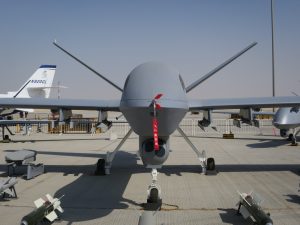As countries across the Middle East diversify their arms suppliers in order to meet emerging security challenges, China is poised to fill the growing demand. However, Beijing is doing very little to prevent its technology from falling into the hands of Tehran’s proxies throughout the region.
According to U.S. Assistant Secretary of State for Near Eastern Affairs Barbara Leaf, the unmanned armed vehicles (UAVs) used by Iranian proxy militias in recent years have been supplied by China. “Those UAVs that [Iranian] proxies use, they’re Chinese,” Leaf told the Senate Foreign Relations Committee on August 4. Leaf added that they were “not provided by the state, but the state does not attempt to curtail that flow.” After procuring drones from China, the Iranian Revolutionary Guard Corps (IRGC) ships them to its dozen proxies dotted across Iraq, Syria, Lebanon, and Yemen.
Iran-backed terror groups have adopted drones, including those provided by China, as staples in their arsenals. In 2019, Iranian-backed Houthis in Yemen used drones to strike oil processing facilities in Saudi Arabia. Two years later, Houthi drones attacked a Japanese-owned and Israeli-managed oil tanker near Oman. In August 2022, Iranian-backed militants in Iraq launched a drone strike on U.S. military bases in southeast Syria.
In addition to hardware, Beijing supplies Iran with advanced satellite navigation and communication systems to enhance drone performance. China’s BeiDou satellite navigation system, a rival to the U.S. GPS system, underpins the drones’ guidance system.
Iran and Pakistan are the only countries that have access to BeiDou’s military-grade signals, which are superior to commercially-available alternatives. Iran Electronics Industries, a state-owned subsidiary of the Defense Ministry, entered into an agreement with China in October 2015 to access BeiDou.
China’s military support for Iran dates back to the Iran-Iraq War, during which China provided armaments to Tehran. In the intervening years, China-Iran relations have made significant strides – most notably in March 2021, when the two countries agreed to a 25-year “Comprehensive Strategic Partnership.” The deal will see an eye-watering $400 billion invested in deepening bilateral economic, military, and security cooperation.
China is shrewdly exploiting tensions between Saudi Arabia and Iran by supplying both countries with UAVs. Fearing Iran’s bellicosity, Saudi Arabia entered into a deal with China in March to construct a drone factory in to produce UAVs domestically. State-owned defense conglomerates from each side, the Saudi Advanced Communications and Electronics Systems Co. and China Electronics Technology Group, inked the deal.
Riyadh has purchased Chinese drones from as early as 2014, when it acquired the Wing Loong II and CH-4 reconnaissance and strike drones. These specific models are copies of American drones, and both can carry a payload of two air-to-surface missiles.
Prior to 2016, China was not regarded as a major exporter of arms to the Middle East. However, today China finds ready buyers throughout the region. In her comments, Leaf noted that “The Chinese have gotten more than their foot in the door, precisely because of their virtual monopoly on drone technology, and they have spread it across the region helter-skelter.”
The UAE purchased Wing Loong drones in 2011 and 2017. Iraq put in an order for China’s CH-4B drones in 2015. Jordan bought CH-4Bs in 2016 (and later had buyer’s remorse and tried to resell them). Earlier this year, Algeria bolstered its aerial capabilities with the acquisition of CH-5s – the next iteration in the CH-4B series.
As countries across the region look elsewhere for suppliers, the United States has felt pressure to reiterate its commitment to regional partners. In July, U.S. President Joe Biden addressed the Gulf Cooperation Council in Saudi Arabia and affirmed, “We will not walk away and leave a vacuum to be filled by China, Russia, or Iran.” However, the United States’ regional partners continue to seek out both American and Chinese hardware.
The mounting threat from Iran and its proxies has catalyzed the drone buying spree. The shifting strategic landscape warrants greater investment in weapons platforms and defense technology to meet contemporary security needs. Diversification of suppliers and solutions is central to the new security architecture of the Middle East.
However, Middle Eastern countries should tread carefully, lest they fall into an arms race orchestrated by Beijing. China’s arming of Iran creates a vicious cycle: Beijing aids and abets Tehran’s terror, regional parties correspondingly drive up demand for arms, and China makes clear that it is willing to meet demand. Cautious and limited diversification may prove to be a more prudent approach for middle-powers in the region that wish to address their valid security needs without over-reliance on China.

































